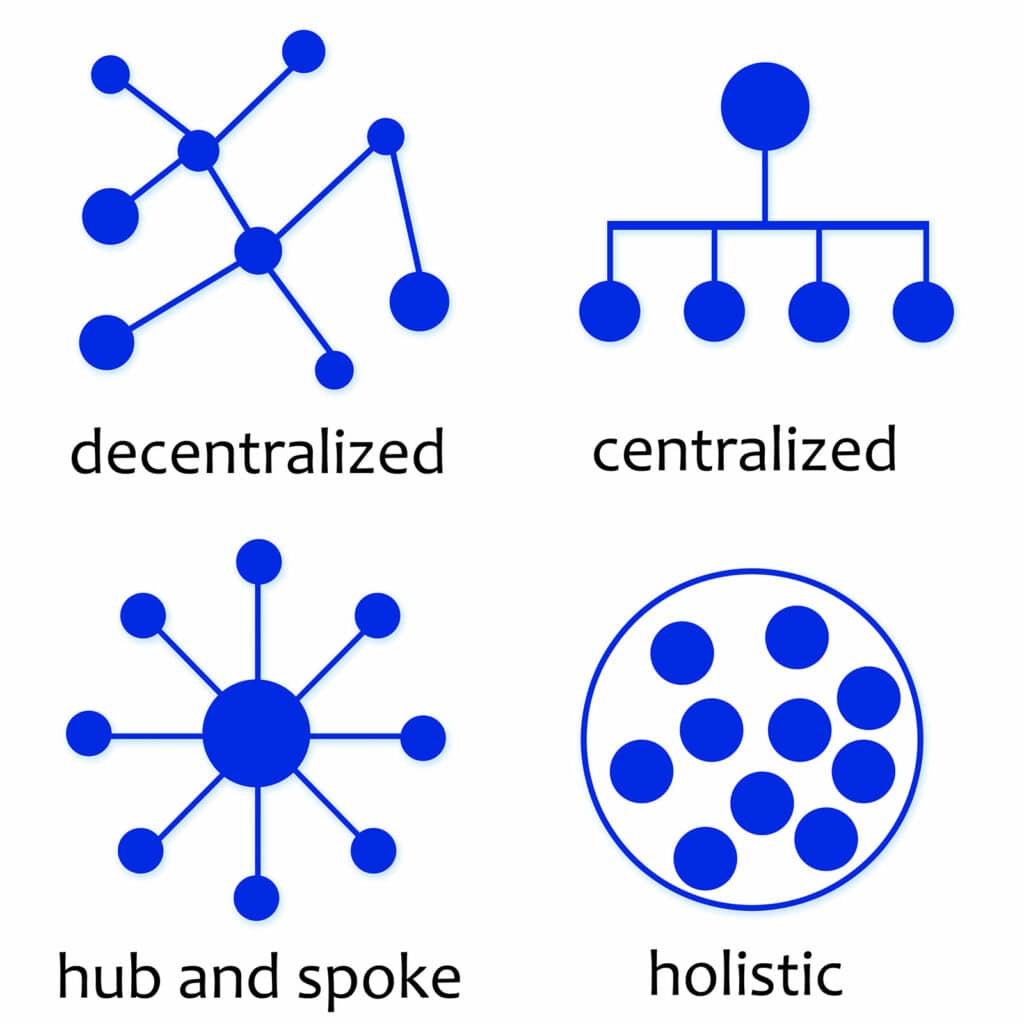A strong SEO strategy focuses heavily on content creation, but you also must consider how you’ll organize that content. Adding blog posts, product listings, location pages, or other pieces of content to your website without creating a hierarchy or hyperlinking structure may not help you appeal to search engines. Instead, one of the best things you can do to boost your site’s search rankings is to utilize pillar pages.

Ranking factors for Google and other search engines change constantly, but pillar pages are a great SEO strategy. To increase your search rankings and expand your audience, you should understand what pillar posts are and how to use them.
Table of Contents
What Are Pillar Pages?
A pillar page is a central landing page on your website that covers a broad topic and links to other pages with more specific information. It’s the foundation of a topic cluster, a group of pages with related content. Topic clusters use a hub-and-spoke organization model, and the pillar page acts as the central hub. The spokes are Internal links to pages that offer detailed information about subtopics within the broader category.
Pillar posts are an excellent way to organize your site’s content and ensure you have a consistent and easy-to-understand system for internal links. Most websites have a few pillar posts offering an overview of topics related to their brand, and each pillar page typically links out to 10 to 20 other pages. However, this can vary greatly depending on your categories and the amount of site content you have.
Some website owners find it easy to sort their site content into separate categories where each spoke connects to only one central hub. In other cases, though, there may be some overlap between categories. Certain pages may relate to multiple topic clusters, so you can include links to these pages from multiple pillar posts. The goal is to create a clear and organized hierarchy as possible.
How Pillar Pages Help Your Site’s SEO
Incorporating a pillar page strategy into your website organization can have an immediate positive impact on your search rankings. The following are the three main benefits of using pillar posts:
Adds Structure to Your Website
Search engine algorithms don’t just examine each page on the web to determine search rankings. They use internal links to understand how your website is organized and how the pages relate to one another, which is why having a clear and consistent linking strategy is essential.
A pillar post system creates a map of your site content. It outlines the landing pages that offer broad information and the pages that answer more specific queries. This allows search engine algorithms to crawl your site and discover every page, which significantly increases the chances of your site ranking in search engine results pages (SERPs), such as google search.
Boosts Rankings for Popular Keywords
The internet is so flooded with websites and content that it can be difficult for smaller sites to rank for broad or vague keywords. Smaller businesses are more successful when they target particular, long-tail keywords instead of short and general ones. However, a pillar page system can help any site perform better with popular keywords.
While you should never underestimate the importance of long-tail keywords, your pillar page can provide an opportunity to target high-volume search terms. People search for broad terms for general information about a topic, and your pillar post fulfills that need.
Increases User Interaction
Searchers often click on results that offer an overview of the topic they’re interested in. Then, as they learn, they’re motivated to click on links that provide more detailed information. When you rank on Google with a pillar post, you bring users to a page with links. If your site visitors follow these links, they’ll spend more time on your website and interact more with your content.
Google and other search engines prioritize user experience. When visitors spend a lot of time on a site, it’s a sign that the content is helpful, informative, and engaging. By boosting user interactions, you can increase your search rankings and establish yourself as an authority within your niche.

Types of Pillar Pages
There are several pillar pages templates, and the best pillar post format for your website depends on your content, industry, and overall goals. Here are three of the most common forms of pillar pages:
10x Content Pillar Page
A 10x content pillar page is the most common type of pillar post. It’s usually a lengthy post that offers educational information about a topic related to your business. While the 10x content page itself should provide plenty of helpful and detailed information, it also links to several blog content posts or other pages that go more in-depth on related topics.
For example, if you’re building a website for a dentist’s office, you might write a 10x content pillar post about treating cavities. This page should explain how cavities form, how they’re treated, and what patients can expect from their dentist visits. However, you can also create additional pages about more specific topics, like risk factors for developing cavities, health complications from cavities, and a step-by-step breakdown of the cavity-filling process.
Resource Pillar Page
While a 10x content pillar page provides a good deal of information on its own, a resource pillar post functions as a reference page, resource pages include a compilation of links with information related to a central topic. A site visitor may not find the answer to their question on the reference page itself, but they can find links to posts that tell them everything they need to know.
Product or Service Pillar Page
Businesses that offer many products or services can benefit from creating a product pillar page. Like a resource page, this pillar post links to other pages that tell the site visitor precisely what they need to know. The product or service pillar page may provide a general overview of what the brand offers. Still, its primary purpose is to direct users to the specific product pages they’re looking for.
How to Create an Effective Pillar Page
Pillar content should be the foundation of your organizational and linking strategies, so it’s important to approach them thoughtfully. Here are five steps for building an SEO-friendly pillar page content:
Research Your Topic to Identify Keywords
Before you write any content, you need to identify your target keywords. Start by writing down a few phrases related to your niche. Then, you can use a tool like Google Keyword Planner to generate a list of keyword ideas. Research the search volumes for these terms to understand how competitive they are.
Identify a short and broad phrase you hope to rank for with your pillar post. Then, you can brainstorm a few long-tail keywords to target with your other topic cluster content pages.

Create a Topic Cluster
Your topic cluster includes your main pillar post and several pages with more in-depth information. Making content clusters help to boost organic search rankings and organic traffic. You can start by outlining your pillar page and using this outline to brainstorm ideas for specific posts. If you already have existing website content, try to sort the web pages into categories.
Start With Your Cluster Pages
When it comes time to write your content, it’s easier, to begin with, the cluster pages. It would be best if you had a broad idea of what your pillar page will cover, but starting with the cluster pages will ensure that you don’t repeat yourself or offer too much specific information on the pillar page. Then, as you write the pillar page, you’ll already know what cluster pages you can link out to as you mention various topics.
Write an Optimized Pillar Page
Your pillar post should be informative and helpful, but it doesn’t need to go into excessive detail. Optimize the content by including your keyword naturally in headers, tags, and within the first 100 words of the body of the post. People often skim through pillar posts, so you can make the page easy to read by breaking up the content into small paragraphs and including bulleted lists.
Build Your Linking Strategy
The pillar page must include links to every cluster page, and every cluster page should link back to the pillar page. Spread your links throughout the post, and ensure the anchor text reads naturally and is highly relevant to the cluster page you’re linking to. Although your goal is to appeal to Google’s algorithms, search engines penalize sites for spamming and stuffing.
Pillar pages make it easier for users to navigate your website, and they can significantly boost your search rankings. If your site doesn’t currently use a pillar post system for organization, switching to this model is one of your best options for strengthening your SEO strategy. You can adjust your existing content to fit this system or create new quality content to fit your topic clusters. What’s most important is that you offer high-quality information so that Google recognizes your website’s value.
FAQ
What is a pillar page?
What are the benefits of having a pillar page?
How do I create a pillar page?
What should I include on my pillar page?
How often should I update my pillar page?
Can I have more than one pillar page?
What is the difference between a pillar page and a blog post?
Published on: 2022-02-05
Updated on: 2024-11-06